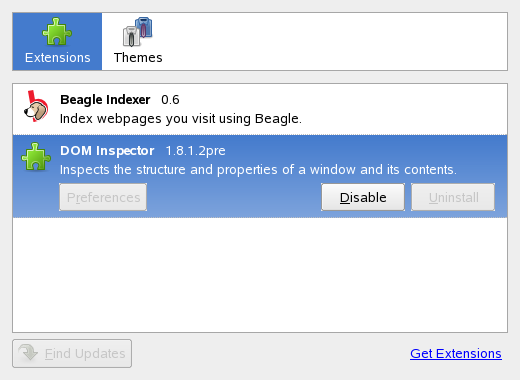13.6 Customizing Firefox
Firefox can be customized extensively. You can install extensions, change themes, and add smart keywords for your online searches.
13.6.1 Extensions
Mozilla Firefox is a multifunctional application, which means that you can download and install add-ons, known as extensions. For example, add a new download manager and mouse gestures. This has the advantage that Firefox itself stays small and lean.
Extensions let you personalize Firefox to exactly fit your needs. With the help of extensions you can change Firefox's look and feel, enhance existing functionality (such as the download manager or tabbed browsing) or add functions such as a Web log editor, Bit Torrent support or even a music player. Certain extensions also assist Web developers while others increase security by dynamically blocking active contents. More than 1000 extensions are available for Firefox. With the add-ons manager you cannot only install new extensions, but also disable, enable, or delete them. It also finds updates to installed extensions.
To add an extension, start the add-ons manager with . Click on the tab and then on in the bottom-right corner to open the Firefox extensions Web page, where you can browse extensions by category. You may also visit http://addons.mozilla.org/ directly. To install an extension, click on the link on the page describing the extension. In order to activate the extension, Firefox needs to be restarted.
Figure 13-3 Installing Firefox Extensions

In order to disable or activate a temporarily disabled extension, click on an extension in the add-ons manager and choose or . To definitely remove an extension, use . Firefox always has to be restarted for the change to take effect.
13.6.2 Changing Themes
If you do not like the standard look and feel of Firefox, install a new theme. Themes do not change the functionality, only the appearance of the browser. Installing a theme is very similar to installing an extension. Start the add-ons manager as described in Section 13.6.1, Extensions and click on the tab. Open the themes Web page by clicking on in the bottom right corner. Proceed as described in Section 13.6.1, Extensions.
Figure 13-4 Installing Firefox Themes

You can always switch between installed themes by clicking and then . However, Firefox has to be restarted for the change to take effect. If you do not use a theme anymore, you can delete it in the same dialog with .
13.6.3 Adding Smart Keywords to Your Online Searches
Searching the Internet is one of the main tasks a browser can perform for you. Firefox lets you define your own smart keywords: abbreviations to use as a URL shortcut for searching a particular Web site. For example, if you often search within Wikipedia, assign a smart keyword to this search in order to simplify this task:
-
Go to http://en.wikipedia.org.
-
After Firefox displays the Web page, right-click on the search field within the Wikipedia Web page and choose from the menu that opens.
-
The dialog appears. In , enter a name for this smart keyword, for example, .
-
Enter your for this search, for example .
-
With , choose the location within your bookmarks where to save this smart keyword.
-
Finalize with .
You have successfully generated a new keyword. Whenever you want to search in Wikipedia , you can now type ws SEARCHTERM into the navigation bar.